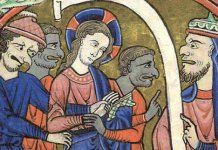“If you are a Christian in the Middle East, there’s only one place where you are safe,” asserted Prime Minister Benjamin Netanyahu, speaking to Christian Zionists in Rio de Janeiro in December 2018. “There’s only one place where the Christian community is growing, thriving, prospering. That’s in the State of Israel.”
Netanyahu’s claim is a central element of the image Israeli officials put forward about the country when speaking to Western audiences.
Ahead of Christmas last year, Israel’s official Twitter account posted a video of the Foreign Ministry’s Digital Diplomacy chief David Saranga on a “magical Christmas stroll” through Jerusalem’s Old City.
The picture of safe coexistence painted by Israeli officials is starkly at odds with the experiences Jerusalem’s Christian leaders themselves describe. While they readily acknowledge that there is no organized or governmental effort against them, Christian clergy in the Old City tell of a deteriorating atmosphere of harassment, apathy from authorities, and a growing fear that incidents of spitting and vandalism could turn into something far darker.
And with Netanyahu already under scrutiny from Western allies over policies toward the Palestinians and attempts at judicial reform, deteriorating safety for Christians — or at least Church leaders disseminating that narrative — could become another serious diplomatic problem for Israel’s embattled government.
March of the schoolchildren
On Friday, hundreds of Catholic schoolchildren in Jerusalem embarked on their traditional march along the Via Dolorosa as they do every year during the 40 days of Lent.
This time was different, however.
The students set off from the Church of the Flagellation, the second station of the cross, all clad in identical red scarves that bore the image of a broken statue of Jesus, the Scourged Savior effigy vandalized by an American Jewish tourist in the church in February.
The march, joined by the two senior Catholic figures in the Holy Land — Patriarch Pierbattista Pizzaballa and Custodian of the Holy Land Francesco Patton — was not limited to a protest against that one incident.
“We are horrified and hurt in the wake of the many incidents of violence and hatred that have taken place recently against the Catholic community in Israel,” said Patton, also known as the Custos.
He cited seven incidents that have taken place in recent weeks, saying pointedly that “it is no coincidence that these serious incidents are taking place specifically now.”
“We expect and demand from the Israeli government and law enforcement to act with determination to stamp these serious phenomena.”
While there have long been periodic incidents of vandalism and harassment against Christian clergy in Jerusalem’s Old City, there has been a noticeable rise in attacks in recent weeks.
In November, two soldiers from the Israel Defense Forces’ Givati Brigade were detained on suspicion of spitting at the Armenian archbishop and other pilgrims during a procession in the Old City.
In early January, two Jewish teens were arrested for damaging graves at the Protestant cemetery on Mount Zion.
The next week, the Maronite community center in the northern city of Ma’alot-Tarshiha was vandalized by unknown assailants over the Christmas holiday.
Jerusalem’s Armenian community buildings were also targeted by vandals, with multiple discriminatory phrases graffitied on the exterior of structures in the Armenian Quarter. According to the Armenian Patriarchate, “revenge,” “death to Christians,” “death to Arabs and gentiles” and “death to Armenians” were all graffitied in the quarter.
The attacks kept coming. On a Thursday night in late January, a gang of religious Jewish teens threw chairs at an Armenian restaurant inside the city’s New Gate. The vandalism at the Church of the Flagellation occurred the very next week.
Read it all in The Times of Israel










